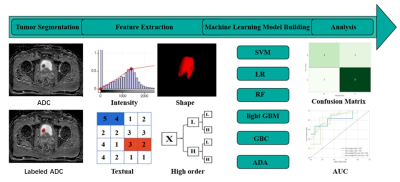3699
A new radiomic tool based on apparent diffusion coefficient to predict the pathological grade of Bladder Cancer1department of radiology, Nanjing Drum Tower Hospital, The Affiliated Hospital of Nanjing University Medical School, Nanjing, China, 2Department of Biomedical Engineering, Guangzhou Medical University, Guangzhou, China, 3Philips Healthcare, Shanghai, China
Synopsis
The present study tried to develop a new radiomics tool based on apparent diffusion coefficient to predict the pathological grade of Bladder cancer (BCa). The results demonstrate that the radient boosting classifier (GBC) achieved the best effect in distinguishing pathological low or high grade of bladder cancer. And GBC also shows the best accuracy when we added the arch bridge sign on MRI as a new feature. This classification performance may suggest that the proposed method is a promising approach for preoperatively evaluating pathological grade in bladder cancer, which is very important for the choice of clinical treatment options.
Background
Bladder cancer (BCa) is a common malignancy, with over 430,000 men and women diagnosed worldwide every year. Surgical management of different grade of BCa are therefore completely different, transurethral resection (TUR) is usually chosen as the initial treatment for superficial tumors, whereas muscle-invasive tumors are treated with radical cystectomy (RC) or with adjuvant chemotherapy. Arch bridge sign is a specific sign of bladder cancer on MRI, a positive arch bridge sign is indicative of non-muscle-invasive bladder cancer [1]. Furthermore, pathological grade is closely related to invasiveness. Therefore, preoperative differentiation between pathological low and high grades tumors is crucial for the appropriate choice of effective treatment options [2]. Radiomics is an emerging method for extracting quantitative features from medical imaging and assisting clinical decision to improve diagnostic, prognostic, and predictive accuracy. The purpose of this study is to develop a new radiomics tool based on apparent diffusion coefficient to predict the pathological grade of BCa.Methods
A total of 96 patients (including 27 low grade and 69 high grade) with histologically proven BCa were included in this study, these patients were randomly assigned to the training cohort (n = 76) and validation cohort (n = 20). Age, sex, arch bridge sign, muscle layer-invasion, lamina propria-invasion were evaluated. Based on DWI (b value of 1200 s/mm2) and corresponding ADC images, bladder tumors were carefully delineated by two radiologists using IntelliSpace Discovery platform (ISD version 3.0, Philips Healthcare, Best, the Netherlands). The workflow of this study Feature extraction was consistent with the Imaging Biomarker Standardization Initiative and shown in Figure 1. The python package scikit-learn and pyradiomics were used to obtain the radiomic features, and to determine the diagnostic sensitivity and specificity of the model [3,4].Results
The extracted features include intensity features, shape features, texture features, and high order features. A total of 1316 features were ultimately extracted in this study using pyradiomics. With the selected features and the training data set, six base classifiers were built. These included support vector machine (SVM), logistic regression (LR), random forest (RF), light gradient boosting machine (LightGBM), gradient boosting classifier (GBC), and ada boost classifier (ADA). In all classifiers, the gradient boosting classifier (GBC) achieved the best effect in distinguishing pathological low or high grade of bladder cancer, yielded an AUC of 0.821 and an accuracy of 0.850 (Figure 2). The results of feature importance plot showed that img_gradient_firstorder_Minimum is the most important radiomic feature (Figure 3). And GBC also show the best accuracy when we added the arch bridge sign as a new feature (Figure 4), the AUC value improved to 0.833.Conclusions
The imaging radiomics model constructed based on ADC sequence are useful for preoperatively distinguishing the pathological grade of bladder cancer, and the diagnostic efficiency had been improved when adding arch bridge sign which is one of most important clinical features on MRI.Acknowledgements
No acknowledgement found.References
[1] Wang H, Luo C, Zhang F, et al. Multiparametric MRI for Bladder Cancer: Validation of VI-RADS for the Detection of Detrusor Muscle Invasion. Radiology. 2019;291(3):668-674. doi:10.1148/radiol.201918250
[2] Panebianco V, Narumi Y, Altun E, et al. Multiparametric Magnetic Resonance Imaging for Bladder Cancer: Development of VI-RADS (Vesical Imaging-Reporting And Data System). Eur Urol. 2018;74(3):294-306. doi:10.1016/j.eururo.2018.04.029
[3] Pedregosa F, Varoquaux G, Gramfort A, et al. Scikit-learn: Machine learning in Python. The Journal of machine Learning research. 2011; 12: 2825-2830
[4] van Griethuysen J. J. M, Fedorov A, Parmar C, et al. Computational Radiomics System to Decode the Radiographic Phenotype. Cancer Research.2017;77(21): e104–e107.https://doi.org/10.1158/0005472.CAN-17-0339
Figures



